
This project allows students to explore any household items and use them as simple machines to construct a Rube Goldberg project. They can analyze the energy transformation and conservation.
- Material Type:
- Activity/Lab
- Date Added:
- 12/09/2013

This project allows students to explore any household items and use them as simple machines to construct a Rube Goldberg project. They can analyze the energy transformation and conservation.
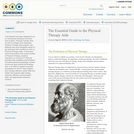
This textbook has been designed to be an introductory training to the entry-level position, Physical Therapy Aide. As part of College of the Sequoias Physical Therapy Aide program, this textbook was used alongside hands-on lab training to train students to work as Physical Therapy Aides. It discusses some of the history and current context of Physical Therapy, provides instruction on common PT Aide job activities (like modalities and transfers), introduces general physiology, reviews commonly-used medical terminology, and, in an effort to embed necessary remediation for the PT Aide program, also includes effective career skills and habits, like business letter writing, resumes, effective communication skills, and appropriate workplace conduct.
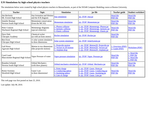
This web page features a collection of Easy Java Simulations developed by secondary teachers for use in introductory high school physics courses. Topics include astronomy, momentum and collision, projectile motion, Gauss's Law and electric field, special relativity, and more. Each simulation is accompanied by a standards-based lesson plan and printable student guides. Users may run the simulations as a Java applet or may directly download a jar file version. The materials in this collection were created with Easy Java Simulations (EJS), a modeling tool that allows users without formal programming experience to generate computer models and simulations. To modify or customize the model, See Related Materials for detailed instructions on installing and running the EJS Modeling and Authoring Tool. This resource is part of Project ITOP (Improving the Teaching of Physics), a graduate program offered at University of Massachusetts-Boston. The archived computer models are hosted and maintained as part of the BU Physics Simulation collection.
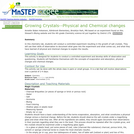
This activity is a classroom lab where students will conduct a controlled activity resulting in the growth of salt crystals, showing a dramatic physical change.

In preparation for this chapter's final project, students will learn how to develop a prototype of a physical object that includes a Circuit Playground. Using a modelled project planning guide, students will learn how to wire a couple of simple circuits and to build prototypes that can communicate the intended design of a product, using cheap and easily found materials such as cardboard and duct tape.
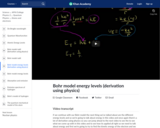
Using classical physics to calculate the energy of electrons in Bohr model. Solving for energy of ground state and more generally for level n. Created by Jay
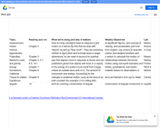
Folder with syllabus and course outline for General Physics (Algebra) I course that uses Openstax College Physics as textbook (https://openstax.org/details/books/college-physics).
This course covers classical mechanics, which essentially means the physics of forces and motion that was developed before the start of the 20 th century. This physics accurately describes the behaviors of objects that are: large enough to be seen with microscopes but smaller than planets or moons, roughly room temperature (give or take a few hundred degrees), and traveling much slower than the speed of light—in other words, most of our everyday experience.
The classical mechanics covered in this course can be boiled down to seven key concepts: Newton’s three laws of motion, the law of universal gravitation, and the laws of conservation of momentum, energy, and angular momentum. We’ll be focusing on these central ideas and how they apply to practical examples.
Course Content and Outcomes
After completion of this course, students will
1) Apply knowledge of motion, forces, energy, and circular motion to explain natural physical processes and related technological advances.
2) Use an understanding of calculus along with physical principles to effectively solve problems encountered in everyday life, further study in science, and in the professional world.
3) Design experiments and acquire data in order to explore physical principles, effectively communicate results, and critically evaluate related scientific studies.
4) Assess the contributions of physics to our evolving understanding of global change and sustainability while placing the development of physics in its historical and cultural context.
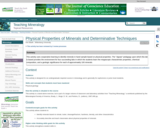
This activity uses cooperative learning to identify minerals in hand sample based on physical properties. The "Jigsaw" pedagogy upon which this lab is based provides the environment for four succeeding labs in which the students learn the megascopic characteristic properties, chemical composition, and a geologic significance for each of approximately 100 minerals.
(Note: this resource was added to OER Commons as part of a batch upload of over 2,200 records. If you notice an issue with the quality of the metadata, please let us know by using the 'report' button and we will flag it for consideration.)
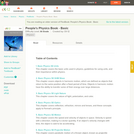
CK-12 Basic Physics - Second Edition updates CK-12 Basic Physics and is intended to be used as one small part of a multifaceted strategy to teach physics conceptually and mathematically.

Vibrations and waves are everywhere. If you take any system and disturb it from a stable equilibrium, the resultant motion will be waves and vibrations. Think of a guitar string—pluck the string, and it vibrates. The sound waves generated make their way to our ears, and we hear the string’s sound. Our eyes see what’s happening because they receive the electromagnetic waves of the light reflected from the guitar string, so that we can recognize the beautiful sinusoidal waves on the string. In fact, without vibrations and waves, we could not recognize the universe around us at all!
The amazing thing is that we can describe many fascinating phenomena arising from very different physical systems with mathematics. This course will provide you with the concepts and mathematical tools necessary to understand and explain a broad range of vibrations and waves. You will learn that waves come from many interconnected (coupled) objects when they are vibrating together. We will discuss many of these phenomena, along with related topics, including mechanical vibrations and waves, sound waves, electromagnetic waves, optics, and gravitational waves.
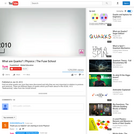
Find out what quarks are, how they were discovered and why they are very important in relation to protons and neutrons. There are different types of quarks which you'll learn about in this GCSE / K12 "Radioactivity" video from the Virtual School.

CK-12 Physical Science Concepts covers the study of physical science for middle school students. The 5 chapters provide an introduction to physical science, matter, states of matter, chemical interactions and bonds, chemical reactions, motion and forces, and the types and characteristics of energy.
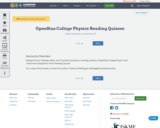
Multiple Choice, Mulitple Select, and True/False Questions covering sections of OpenStax College Physics Text. These were designed to be for Reading QuizzesFor a copy of the answers, contact the author: Catherine Whiting at cwhiting@coloradomesa.edu
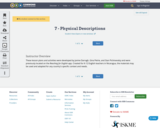
These lesson plans and activities were developed by Janine Darragh, Gina Petrie, and Stan Pichinevskiy and were previously located on the Reaching for English app. Created for K-12 English teachers in Nicaragua, the materials may be used and adapted for any country's specific context and needs.

Most books that use MATLAB are aimed at readers who know how to program. This book is for people who have never programmed before. As a result, the order of presentation is unusual. The book starts with scalar values and works up to vectors and matrices very gradually. This approach is good for beginning programmers, because it is hard to understand composite objects until you understand basic programming semantics.
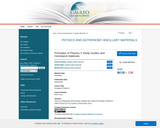
This set of study guides and homework materials was created for Principles of Physics II under a Round Six ALG Textbook Transformation Grant.

This is an open-access textbook for calculus-based introductory physics courses. Anyone that complies with the license is welcome to modify and use this work for their own use, and we hope that you will choose to contribute. The textbook is specifically intended for a flipped-classroom approach, wherein students complete readings at home and the material is then discussed in class. The textbook thus contains questions and activities to engage readers. This text also includes a curriculum in experimental physics, detailing the scientific method and process, suggesting experiments to perform at home and in the lab, and has chapters that cover: writing and reviewing proposals, writing and reviewing reports, analyzing data, as well as an introduction to python. Finally, this textbook was written with many contributions from students! We hope that you may find it useful, and we are interested to know if you are using it!
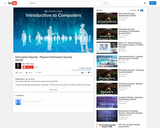
The act of physically protecting the computers. The first rule of any type of computer safety is restricting physical access to it. If a bad guy can get their hands on the computer assume they will be able to gain access to all data contained within.
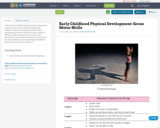
In the study of Child Development, physical growth is a complex process which entails learning about children's bodily movements and abilities. More specifically, gross motor skills are a type of physical abilities in which large muscle movements are exercised by young children during the early years of life. This is glimpse of what typical physical abilities children possess between ages 3 to 5.
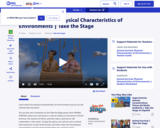
Learn about the physical characteristics of environments and act out the animals that live there!
You are the next contestant on the Take the Stage game show ANIMAL SURVIVAL where you will travel in a hot air balloon to the forest of North America, the savanna of Africa, and then take a submarine ride underwater in the ocean. To play the game, you will act out an animal that would live in each environment, and then write how the physical characteristics of each environment helps your animal survive.
Learning Objective: observe and describe the physical characteristics of environments and how they support populations and communities of plants and animals within an ecosystem.